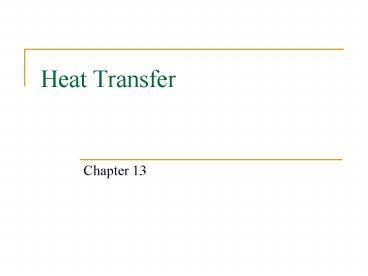Heat Transfer - PowerPoint PPT Presentation
1 / 18
Title: Heat Transfer
1
Heat Transfer
- Chapter 13
2
Expectations
- After this chapter, students will
- Recognize the transfer of heat from one place to
another by convection - Apply the concept of thermal conductivity to make
calculations involving the conduction of heat
through materials - Use the Stefan-Boltzmann law to quantify the
transfer of heat between objects by radiation
3
Convection
- From the Merriam-Webster online dictionary
(http//www.m-w.com/) - Main Entry convection
- Pronunciation kn-'vek-shn
- Function noun
- Etymology Late Latin convection-, convectio,
from Latin convehere to bring together, from com-
vehere to carry -- more at WAY - 1 the action or process of conveying
- 2 a the circulatory motion that occurs in a
fluid at a nonuniform temperature owing to the
variation of its density and the action of
gravity b the transfer of heat by convection --
compare CONDUCTION, RADIATION
4
Convection
- Heat can move from one place to another in a
fluid when a warmer part of the fluid moves to a
cooler place within the fluid. - Heat is transferred by the mixing of hotter fluid
with colder fluid. - Convection happens only in fluids, since it
requires motion within the material.
5
Conduction
- If two parts of an object or substance are at
different temperatures, heat energy moves from
the warmer part to the cooler part without the
transfer of any material. - This transfer of heat is called conduction.
- Conduction occurs in both solids and fluids. The
material doesnt move only the heat moves.
6
Conduction
- The amount of heat transferred by conduction
depends on five things - The transfer time, t. More time, more heat
transferred. - The temperature difference, DT. Larger
difference, more heat transferred. - The cross-sectional area of the conduction path.
Bigger pipe, more heat transferred. - The length of the conduction path. Longer
pipe, less heat transferred. - The material involved. Some materials conduct
better than others.
7
Conduction
- Heat conducted in time t
- SI units of thermal conductivity
cross-sectional area
thermal conductivity
temperature difference
time
heat transferred
length
8
Conduction
- A common problem to be solved intermediate
temperatures in a layered structure of different
materials. - The principle to keep
- in mind the steady-state
- heat flow rate through
- the structure is constant.
9
Radiation
- Every object both radiates and absorbs
electromagnetic waves, according to its size, its
temperature, and the characteristics of its outer
surface. - An object that absorbs all the electromagnetic
waves that encounter it is called a blackbody.
10
Radiation
- The amount of heat radiated by a blackbody whose
surface area is A and whose absolute (Kelvin)
temperature is T, in a time t, is - This is the Stefan-Boltzmann Law for a blackbody.
- Stefan-Boltzmann constant 5.6710-8 J /
(sm2K4)
Stefan-Boltzmann-constant
11
Radiation
- The energy radiated is not equally distributed,
spectrally. The distribution of radiated energy
with wavelength depends on the temperature of the
blackbody, according to the Planck blackbody
radiance function
constants values determined by units used
radiance power per unit area per unit wavelength
12
Radiation
13
Radiation
14
Radiation
- Real objects are not perfect blackbodies. We
define a quantity emissivity - Emissivity is a dimensionless, unitless ratio
between zero and one. (e 1 for a blackbody.) - High-emissivity objects have a flat black
appearance. Low-emissivity objects appear bright
and shiny.
15
Radiation
- Surfaces that are good absorbers are also good
emitters. They have high emissivities
(approaching 1). - A blackbody is both a perfect emitter and a
perfect absorber. - A blackbody has an emissivity of one, no matter
what wavelength of radiation is considered.
16
Radiation
- An object with an emissivity of less than one,
but constant with respect to wavelength
(spectrally neutral) is called a graybody. Most
real objects have an emissivity that is
wavelength-dependent. (They have colors.) - For a graybody object (e between zero and one),
17
Insulation
- Insulation reduces conductive heat transfer by
adding to the conduction path length, reducing
the paths thermal conductivity, or both. - Rearranging our conductive transfer equation
R-value
18
Insulation
- This R-value expresses the combined effects of
additional path length and decreased path
conductivity to express the insulating effect of
a construction material. When a structure is
layered, the R-values may be added. - R-value is defined in unfortunate units
- Satans units of R-value































